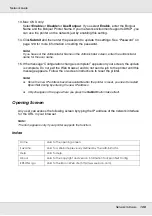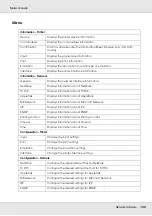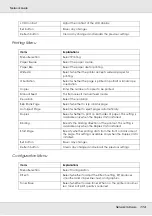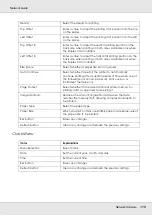
Network Software
107
Network Guide
5. To assign an IP address manually, enter the IP address, the subnet mask, and the
default gateway. Be sure the IP address does not conflict with any other devices on the
network.
Note:
If there is a server or a router functioning as a gateway, enter the IP address of the server or the
router for the gateway address. If there is no gateway, leave the default values there.
6. If you want to get a private address between 169.254.1.1 and 169.254.254.254
automatically when an IP address cannot be obtained by the DHCP server, leave it at
Enable
for
Set Using Automatic Private IP Addressing (APIPA)
; otherwise, select
Disable
.
7. When setting an IP address using the ping command, select
Enable
for
Set Using
PING
. Select
Disable
when setting an IP address with EpsonNet Config; this prevents
any unexpected change of the IP address.
Note:
Be sure to select
Disable
when not using ping; this prevents an unexpected change of the IP
address by EpsonNet WebManager.
8. Select
Enable
for
Acquire DNS Server Address Automatically
if you want to acquire
the DNS server address using the DHCP server.
If you want to enter the DNS server address manually, select
Disable
and then enter
the IP address of the DNS server.
9. Select
Enable
for
Acquire Host Name and Domain Name Automatically
if you want
to acquire the host name and the domain name using the DHCP server.
If you want to specify manually, enter the host name and the domain name in the text
boxes.
10. Select
Enable
for
Register Network Interface Address to DNS Server
if you want to
register the host name and domain name to the DNS server through the DHCP server
that supports Dynamic DNS.
If you want to register the host name and the domain name directly to the DNS server,
select
Enable
for
Register Network Interface Address Directly to DNS Server
.
11. Select
Enable
or
Disable
for
Use Universal Plug and Play
. Select
Enable
if you want
to use the Universal Plug and Play function on Windows Me or future operating
systems.
12. Change the default Universal Plug and Play device name, if desired. This device name
is used for Windows that supports the Universal Plug and Play function.






























